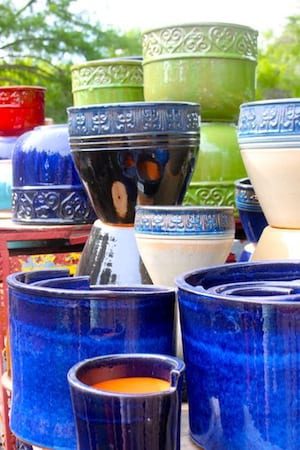March is a good time to observe which of your container plants need some maintenance and may need to be repotted. Many plants outgrow their container throughout the year and can be bumped up to a larger sized container, pruned back, and even divided or propagated to make new plants. Early fall is another time to check in on your potted plants.
Signs that container plants need to be repotted.
1. Water runs straight through the container, or bubbles on the surface of the soil when watering. This could signal that the root ball may have swelled and grown so much that their is little potting soil left in the pot to soak up the water. Circling roots are never good for a plant’s vitality, and lack of soil also means lack of nutrition for your plant.
2. A solid mass of roots are evident on the soil’s surface, or roots are finding their way out of the drainage hole of the potted plant. Plant growth is slowed down in rootbound plants. Rootbound container plants require that you water them more often to keep them alive. (Some plantss like bougainvillea for instance, prefer to be somewhat rootbound. Know your plants!)
3. You notice mineral deposits on the inside of the container of your potted plants, or on top of the soil surface. These mineral deposits are most likely from leftover fertilizer your potted plants did not take up. Over time, these leftover mineral deposits can compete with plants for water uptake.
Items needed for repotting container plants.
1. High quality potting soil
When repotting your container plants, start again with fresh, high quality, potting soil. FoxFarm’s line of potting soils contain a ton of nutrients right in the bag providing a great new start for repotted plants.
- Never use the same potting soil, the nutrients have been all used up.
- Never use garden soil or compost in potted plants. Potting soils are specifically formulated to be light, airy, and well-draining. Garden soils are too dense and soil can become compacted, NOT good for the roots in pots.
2. Brand new pots or disinfected, clean, recycled pots
If your plant growth has been slowed down due to being rootbound, you are going to want to bump up your container to a size about twice the diameter of the current pot.
If you decide to recycle your current pots for smaller plants ready to moved into container that size, empty all existing soil, brush loose mineral deposits from inside of containers, and scrub and disinfect pots with a 9:1 solution of water to bleach.

3. Pruning shears or clippers
If the top of plants are overgrown, they may benefit from a pruning at the time of repotting. Pruning away excess growth or dried woody stems, allows for the plant’s energy to be directed towards the roots at the time of repotting.
If your plant is severely rootbound, with roots circling around like a bowl of spaghetti, you may need to snip the roots a little to loosen them up before repotting. First try to loosen them gently by massaging them with your fingers. If they are still tightly wound, make a couple of snips with pruners towards the bottom and then loosen with fingers.
Things to remember when repotting container plants.
1. Always give your repotted plants a base layer of soil under their roots. Do not just set the plant’s rootball on the bottom of pot.
2. Set plant on top of base layer of soil and align plant so that it will be sitting straight and upright in the container. Fill in potting soil around the sides of the plant’s rootball.
3. No need to pack soil tightly as this prevent roots from growing freely and easily. A gentle tamping of soil around plant base is sufficient, just enough to keep it secure and steady in the container.
4. Do not fill soil all the way to the top of the pot. Leave yourself at least 2″ of space from the top of the container to the top of the soil. This allows for adequate watering without water running off the top of the soil and out of the pot.
We have a rainbow of colors to choose from in our pottery section at Rainbow Gardens. Repot your tired your plants to give them a new leash on life!
~The Happy Gardener, Lisa Mulroy


What do I do if I already have huge pots? I cannot handle anything bigger.
Hi Edwinna,
You can always reuse your pots if your plants are looking healthy and don’t need more room. You can scoop out some of the old potting soil (being careful around roots) and add some more nutrient rich soil to the pots to rejuvenate the old potting soil. Also adding time release granular fertilizer is helpful to give plants nutrients that old soil is depleted of.